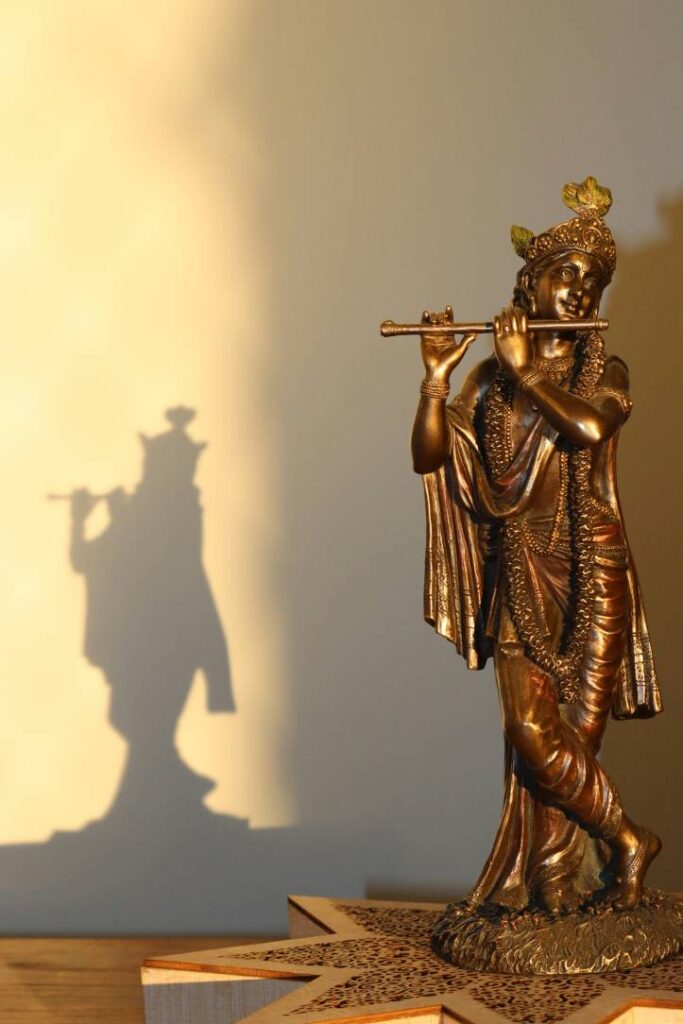Photo by Parag Gaikwad Unsplash
History often appears as an endless cycle of rise and fall, conflict and resolution. However, the Bhagavad Gita, an ancient spiritual text, offers a different perspective. It presents history as His-story, the divine play of Krishna, the ultimate reality. This viewpoint acknowledges the world’s challenges and suffering but invites us to find deeper meaning and purpose behind them.
The Gita’s Cosmic Perspective: Krishna as the Ultimate Historical Agent
In Chapter 11 of the Bhagavad Gita, Krishna reveals his universal form, embodying all creation and time. He declares himself the beginning, the middle, and the end, the source of everything. This cosmic vision reminds us that all events, no matter how chaotic, are part of a larger divine plan.
This understanding can be both comforting and empowering. It helps us see beyond surface-level turmoil and recognize the divine hand at work, orchestrating events for the ultimate good. It also calls us to align ourselves with this divine will, to act according to dharma (righteousness), and contribute to a more harmonious world.
Dharma in Turbulent Times: The Yogi’s Role
Today’s world faces immense challenges — from political polarization to climate change to social injustice. As yogis, what is our role amidst this chaos?
The Gita provides guidance and inspiration. It reminds us of our divine nature, that we are part of the universal consciousness. It calls us to cultivate inner peace and equanimity, even in adversity. It urges us to act with compassion, courage, and wisdom, always striving to uphold dharma.
Discerning Truth Amidst the Noise: The Challenge of Interpretation
The Gita, like any sacred text, is open to interpretation. Different individuals and groups may derive different meanings from its teachings. Thus, it’s crucial to approach the Gita with discernment, humility, and an open mind.
Importantly, the Gita is not a manual for war or violence. While it depicts a battlefield, its deeper message is about the inner struggle between our higher and lower natures. The true battle is within ourselves, and victory lies in overcoming our ego, attachments, and negative tendencies.
Navigating Uncertainty: Finding Our Own Dharma
In turbulent times, it’s easy to feel overwhelmed and unsure of how to act. But the Gita reminds us that we each have a unique role in the unfolding of His-story. By turning inward, cultivating self-awareness, and seeking guidance from our inner wisdom, we can discover our own dharma and contribute to the world’s healing.
This may involve standing against injustice, offering compassion to those suffering, or simply cultivating inner peace and radiating love and light. Whatever form our dharma takes, it’s essential to act with integrity, compassion, and an understanding of our interconnectedness.
Embracing the Divine Play: A Path to Peace and Purpose
The Gita’s message is one of hope and empowerment. It reminds us that we are not victims of circumstance but co-creators of our reality. By aligning with the divine will, we can find meaning and purpose even amid chaos.
As we navigate today’s challenges, let’s remember the timeless wisdom of the Bhagavad Gita. Let’s embrace the divine play of life, cultivate inner peace, and act with courage and compassion. By doing so, we can contribute to a more just, harmonious, and enlightened world.
His-Story Unfolding: Discovering Dharma in the Midst of Chaos was originally published in Moving into Stillness on Medium, where people are continuing the conversation by highlighting and responding to this story.

